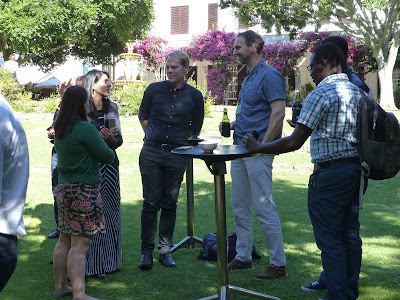The Blue Train is often regarded as South Africa's equivalent of the Orient Express, a luxury train travelling the 1000 miles between the capital, Pretoria, and the "mother city" of Cape Town. It is often the visitor's introduction to the diversity of this huge country, and a potential option for MEI Conference delegates travelling via Johannesburg, as Pretoria is a short bus transfer from the airport.
After last week's conferences in Cape Town, Barbara and I flew up to Johannesburg and then on to Pretoria to experience the journey for ourselves, with a view to offering advice to future conference attendees. We chose the Pretoria to Cape Town option, rather than the return route, as it offered a 2 hour tour of the diamond mining town of Kimberley.
We left Pretoria station at 8.30 am on Monday, and headed for Kimberley, passing through some of South Africa's most dreary scenery, a landscape of gold mining tailings dumps, sprawling shanty towns and the flat, rubbish-strewn scrublands of Gauteng and the North West Province.
 |
| Tailings dumps on the horizon above the township near Potchefstroom |
Due to interminable stops, the train was several hours late arriving in Kimberley, so the excursion was cancelled, and we later learned that it is very rare for the visit to actually happen, so this was a great disappointment.
After a fine dinner with good food, wine and company we retired to our cabin, waking early the following morning to the endless flat vista of the Northern Cape's Great Karoo plateau, and towards another long stop at Beaufort West in the Western Cape.
 |
| Dinner on the Blue train |
Then thirty hours after leaving Pretoria we emerged from the 11 mile long Hex River tunnels into the land of the travel brochures, the beautiful Cape Winelands and the town of Worcester.
 |
| A long stop in Worcester |
 |
| Wine estates near Worcester |
 |
| Arriving in Cape Town |
The Blue Train is without doubt an exceptional experience. The train itself is certainly luxurious, the service is first rate and the staff very professional and friendly, and we met some very interesting fellow travelers. However the many delays were frustrating and offering an excursion to Kimberley is misleading as it happens so rarely.
Many people might say that there are better ways to spend two days in South Africa, but we have no regrets about experiencing this very expensive journey. Just as trips to Robben Island and the townships show tourists that South Africa is not all about pristine wine regions and golden beaches, so the Blue Train gives a taste of the South Africa that you do not find in travel brochures. Functional rail lines are built where possible on the easiest and flattest routes, rather than through picturesque mountains, and it is only in the last few hours of the journey that the train follows the stunning valleys of the Cape winelands. The bulk of the journey passes through some of the most desolate regions of the country, areas of extreme poverty with high crime rates where rubbish is piled high around the flimsy shacks. Nevertheless, as we drifted by in our luxurious bubble, sipping our afternoon cocktails, in most cases we were greeted with friendly waves and only occasional hostility - the observation carriage three times being hit by bricks, shattering windows!
 |
| Contrasting images from the Blue train |
So basically, if you know what to expect, that for the most part you will not be enjoying stunning scenery, I would recommend that this is an excursion that should be on the bucket list of every traveler to this land of extreme contrasts. It will certainly make you realise how fortunate you really are.
Twitter @barrywills



















































.jpg)










